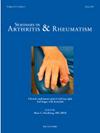CAR T-cell therapy in SLE: A systematic review
IF 4.4
2区 医学
Q1 RHEUMATOLOGY
引用次数: 0
Abstract
Introduction
CAR T-cell therapy is poised to revolutionize the treatment of SLE. Several publications reported on small numbers of SLE patients treated with CAR-T.
Objective
To review and summarize the available clinical evidence published or presented to date on the use of CAR therapy in SLE.
Methods
We conducted a systematic review to evaluate all clinical studies assessing safety and efficacy outcomes of CAR therapy in SLE. For this review, we followed PRISMA recommendations. MEDLINE (PubMed), Embase, Scopus, and CENTRAL were consulted.
Results
The search strategy yielded 5905 results, of which 16 studies were included, encompassing 145 participants. Pooled analysis of the 102 individual SLEDAI scores available showed the mean baseline SLEDAI of 13.1 (95% CI 12.3–13.9) decreased to 2.3 (95% CI 1.5–3.1) after 6 months, and 1.4 (95% CI 0.3–2.4) after 12 months. DORIS remission was achieved in 45/64 patients (70%) and LLDAS in 50/56 (89%). CRS occurred in 81 (56%) participants, of which 80 (98%) were grade 1 or 2, and 1 (2%) grade 3. ICANS was reported in four patients, 1 grade 1, 1 grade 2, 1 grade 3, and 1 grade 4. Eleven patients (7.6%) developed serious infections, including one case of fatal pneumococcal meningitis.
Conclusion
This systematic review evaluated all the available clinical evidence on the use of CAR T-cell therapy in patients with SLE. The findings reinforce the efficacy of this treatment modality and underscore the need for further research to better define its role in SLE management.

CAR - t细胞治疗SLE:一项系统综述
car - t细胞疗法有望彻底改变SLE的治疗。一些出版物报道了CAR-T治疗的少数SLE患者。目的回顾和总结迄今为止发表或提出的关于CAR治疗SLE的临床证据。方法:我们对所有评估CAR治疗SLE安全性和有效性的临床研究进行了系统评价。在这次审查中,我们遵循了PRISMA的建议。参考了MEDLINE (PubMed)、Embase、Scopus和CENTRAL。该搜索策略产生了5905个结果,其中包括16项研究,涉及145名参与者。102个个体SLEDAI评分的汇总分析显示,平均基线SLEDAI在6个月后从13.1 (95% CI 12.3-13.9)降至2.3 (95% CI 1.5-3.1), 12个月后降至1.4 (95% CI 0.3-2.4)。64例患者中有45例(70%)达到DORIS缓解,50例(89%)达到LLDAS缓解。81例(56%)参与者发生CRS,其中80例(98%)为1级或2级,1例(2%)为3级。4例患者报告了ICANS, 1例1级,1例2级,1例3级和1例4级。11名患者(7.6%)发生严重感染,包括1例致命性肺炎球菌脑膜炎。结论:本系统综述评估了所有关于CAR - t细胞治疗SLE患者的临床证据。研究结果加强了这种治疗方式的有效性,并强调需要进一步研究以更好地确定其在SLE管理中的作用。
本文章由计算机程序翻译,如有差异,请以英文原文为准。
求助全文
约1分钟内获得全文
求助全文
来源期刊
CiteScore
9.20
自引率
4.00%
发文量
176
审稿时长
46 days
期刊介绍:
Seminars in Arthritis and Rheumatism provides access to the highest-quality clinical, therapeutic and translational research about arthritis, rheumatology and musculoskeletal disorders that affect the joints and connective tissue. Each bimonthly issue includes articles giving you the latest diagnostic criteria, consensus statements, systematic reviews and meta-analyses as well as clinical and translational research studies. Read this journal for the latest groundbreaking research and to gain insights from scientists and clinicians on the management and treatment of musculoskeletal and autoimmune rheumatologic diseases. The journal is of interest to rheumatologists, orthopedic surgeons, internal medicine physicians, immunologists and specialists in bone and mineral metabolism.

 求助内容:
求助内容: 应助结果提醒方式:
应助结果提醒方式:


